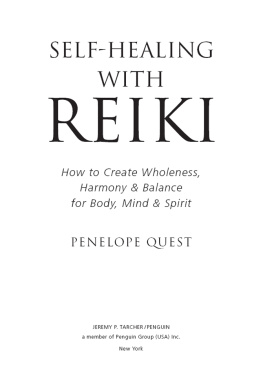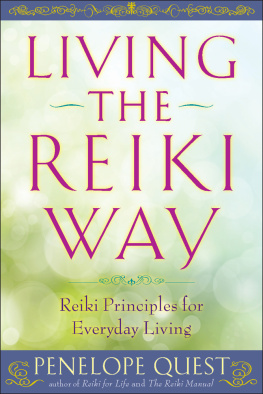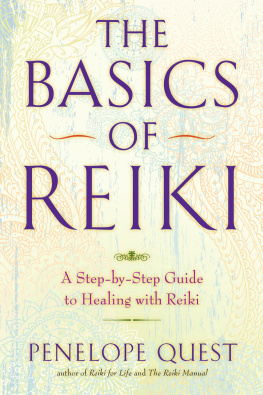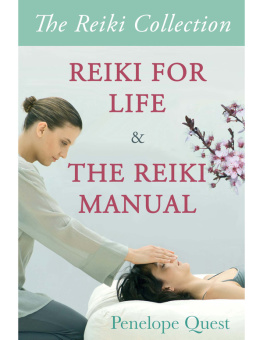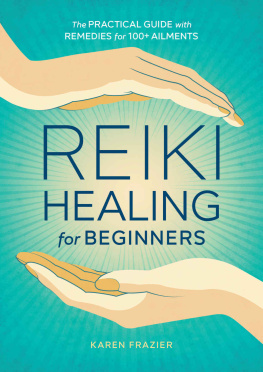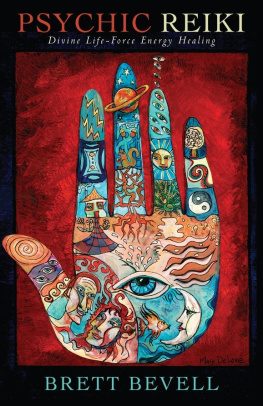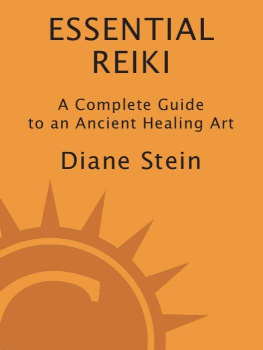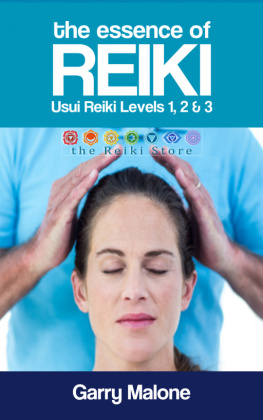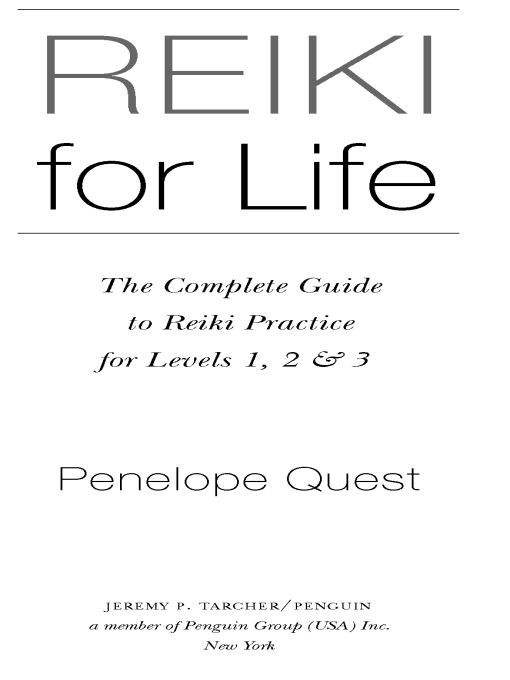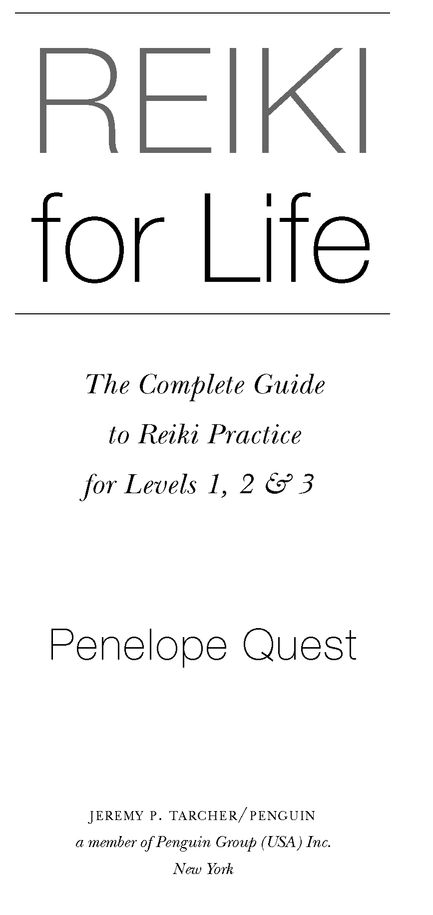Table of Contents
This book is dedicated to Mikao Usui, without whom the world would not have received the wonderful gift of Reiki.
Acknowledgments
I would like to express my heartfelt gratitude to the many people who have helped, directly or indirectly, with this book:
To Kristin Bonney, who started me on my Reiki journey and set me a good example to follow;
To William Lee Rand, who initiated me as a Master in Usui Reiki, Usui/Tibetan Reiki and Karuna Reiki, and who encouraged me to always be myself in Reiki;
To Frank Arjava Petter and Chetna Kobayashi, for bringing the first translation of Usuis original Reiki manual to the West;
To Hiroshi Doi, and his students Andy Bowling and Ann Rogers, for their knowledge and experience of the original Japanese techniques;
To the Reiki Association, and to Light and Adonea, for the information about different forms of Reiki;
To the UK Reiki Federation, for the information on legal issues;
To the many spiritual teachers who have guided and inspired me, especially Gill Edwards, Karen Kingston, Mike Robinson, and Orin and DaBen;
To my friends and fellow Reiki Masters Carol and Mark Melling, Wendy Monks and the Rev. Simon John Barlow, for the inspirational example they set as people who really walk their talk;
To my son, Chris, and daughter, Kathy, for their loving support and practical help;
And to all my Reiki students, for the love and learning they have brought me.
Introduction
Reiki for Life is aimed at anyone interested in healing and self-healing with Reiki at any level, from absolute beginners to Practitioners and Masters. Unlike other books on Reiki, it is a complete guide to Reiki practice, giving all the Reiki techniques from the well-known Western tradition, including some never in print before. It also presents additional methods originally used by Dr. Mikao Usui, the founder of the Reiki healing system, which until recently were only available to Reiki students in Japan.
The book explores for the first time the true depth, power and promise of this wonderful healing system. From the development of Reiki in both Japan and the West to a comprehensive description of First and Second Degree techniques, it provides an essential resource for Reiki practice in the twenty-first century. It looks at the necessary background information about energy and metaphysical beliefs and provides a thorough foundation in the basics of self-treatment and how to treat others with Reiki at First Degree. However, it goes much further than other books: it emphasizes the holistic nature and spiritual aspects of Reiki and examines the personal and spiritual impact of becoming a Practitioner or a Master. It explains in detail how to carry out distant healing treatments and methods to heal and let go of personal problems as well as many other advanced techniques. In addition, it shows how the newly discovered Japanese techniques for energetic cleansing, healing and spiritual development can be used to enhance your practice of Reiki. Its aim, therefore, is to help anyone at any level to reach his or her full potential as a healing channel for Reiki.
There are traditionally three levels of qualification in Reiki. Reiki First Degree opens up the inner healing channel so that people can then use it for self-healing and healing others for the rest of their lives. At Reiki Second Degree three sacred symbols are taught, as well as some special techniques that intensify the Reiki and enable people to carry out effective distant (absent) healing, as well as other methods that promote deep healing of physical, mental and emotional problems. Reiki Third Degree is the level of a Reiki Mastersomeone who has committed his or her life to learning the mastery of Reiki, and who is qualified to teach others this amazing and powerful healing system.
Part I of the book begins by explaining what Reiki is and how it was discovered, and how it links with other energies in humans, animals, plants and the rest of the environment. It discusses the processes of healing from both conventional and traditional viewpoints, and provides comprehensive information about Reiki training, including what to expect from courses at each level.
Part II covers everything you need to know at Reiki First Degree, including methods for self-healing and how to carry out treatments on other people and animals, as well as some creative ways of using Reiki. In Part III there is a thorough explanation of the real impact and creative power of Second Degree, including how to use the Reiki symbols for self-healing and hands-on treatments of others, and how to carry out distant healing. A wide range of other advanced techniques is included, too, such as using Reiki to empower goals, heal emotional problems, create sacred space and protect yourself and those you care about.
Part IV introduces techniques only recently brought to the West from the Japanese Reiki traditions, including methods for self-cleansing and removing toxins from the body, as well as alternative ways of using the hands, such as patting and stroking, during Reiki treatments. The final section, Part V, looks at the importance of spiritual development with Reiki, and discusses what is needed to set up as a professional Practitioner, as well as how to become a Reiki Master.
Since the beginning of the 1990s, interest in complementary medicine and alternative therapies has increased tremendously.
Everywhere you look or listen there are television and radio programs and newspaper and magazine articles on holistic health and healing, and ways to improve your life physically, emotionally, psychologically and spiritually. For me the turning point was taking a course in Reiki, a hands-on healing technique that originated in Japan, and from that day in 1991 my life has changed for the better.
I began my journey of personal and spiritual discovery back in the 1970s with a growing interest in psychic abilities, but since that first Reiki course my main focus has been mind-body healing techniques and spiritual growth, although I have also developed skills as a clairvoyant and psychic channel. I worked for three years as a Reiki Practitioner before becoming a Reiki Master/Teacher of both the Usui Shiki Ryoho and Usui/Tibetan traditions in 1994, and a Karuna Reiki Master/Teacher in 1996. In 2000 and 2003 I gained further experience and qualifications in the original techniques of Dr. Usui, the founder of the modern system of Reiki healing, which had only just been rediscovered after research into the Reiki traditions in Japan.
Over the past ten years or so I have continued to extend my knowledge and experience by studying a wide range of subjects, including meditation and visualization, NLP (neurolinguistic programing), kinesiology, metamorphic technique, Native American and contemporary shamanism, dowsing, feng shui and other topics that promote understanding, personal growth and a holistic view of the person. But my first love is, and always will be, Reiki.
My professional background and qualifications are in psychology, education and management, but in 1996 I gave up my career as a lecturer and senior manager at a college to enable myself to devote more time to teaching and writing books about Reiki. My first paperback, An Introduction to Reiki, was published by Piatkus in March 1999 (revised in 2007 as


